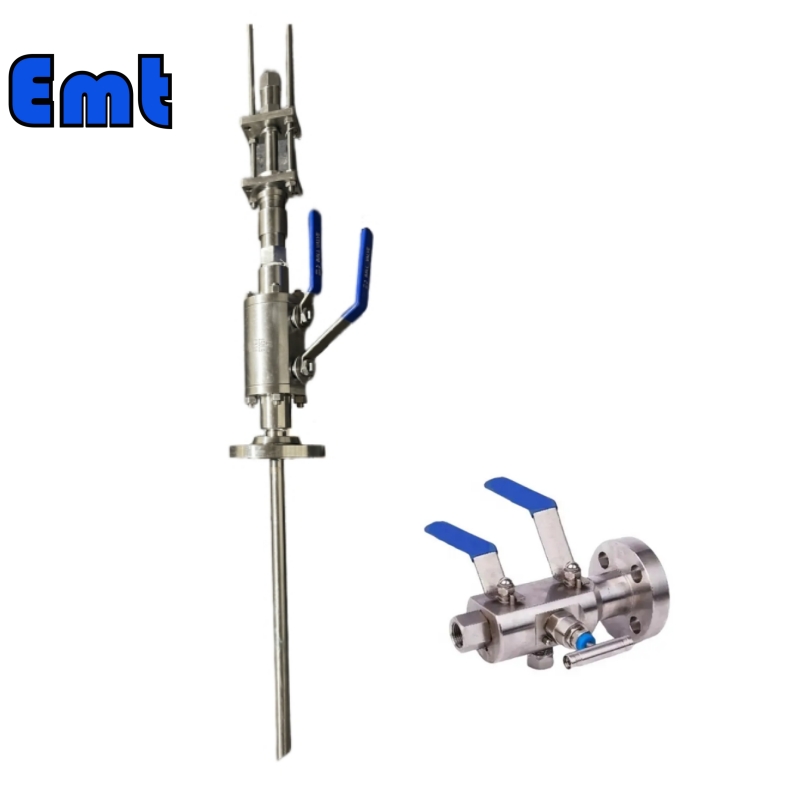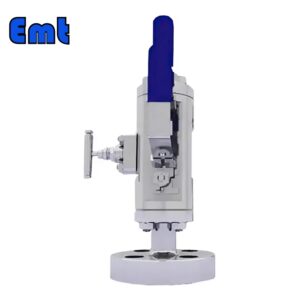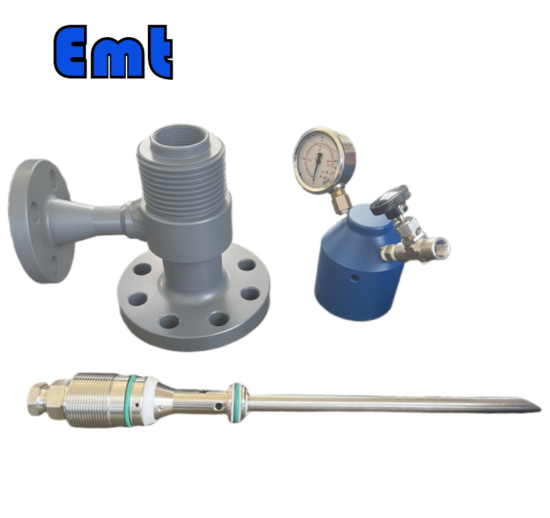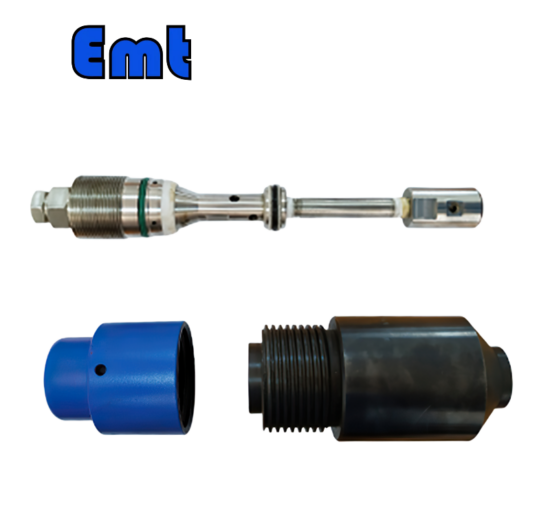معرفی
The EMT Chemical Injection Quill combined with a Double Block and Bleed (DBB) valve represents a significant advancement in fluid handling technology, offering a compact, efficient solution for precise chemical dosing while ensuring system integrity and safety.
In modern industrial applications, there is a critical need for precise chemical injection and process sampling. These operations must occur under full operating pressures and temperatures to maintain system integrity and efficiency. Industries such as oil and gas, petrochemicals, and pharmaceuticals frequently require the introduction of chemicals directly into the process stream. These chemicals, including de-waxing, de-icing, or de-foaming agents, help maintain the smooth flow of media through pipelines.
Simultaneously, process sampling plays a vital role in quality control, ensuring that the fluid compositions adhere to strict specifications. Both activities necessitate robust equipment capable of handling these tasks without compromising the system’s safety or performance. This is where Double Block and Bleed Valves come into play. Equipped with Injection Quills or Sampling Probes, these valves offer a compact and efficient solution.
Our company has innovated within this field by offering Double Block and Bleed Valves that integrate these functionalities seamlessly. Whether opting for one-piece body DBB, Modular Type, Monoflange Valves, or Manifold Valves, users can fit these with either an Injection Quill or Sampling Probe. This flexibility ensures that they can meet specific operational requirements while maintaining a high level of safety and efficiency.
Specifications of EMT Chemical Injection Quill
| نام | Pipeline Chemical Injection Quill Sampling System |
| مواد | فولاد ضد زنگ 304، فولاد ضد زنگ 316، DSS F51، فولاد کربن A105N، اینکونل 625 |
| دمای عملیاتی | -20±120 |
| ویژگی | 1. Easy Operating |
| 2. High Accuracy Long Life | |
| 3. High Efficiency, Low cost | |
| پرداخت | TT/LC |
| مزیت - فایده - سود - منفعت | اولا، آنها سبک و انعطاف پذیر هستند. |
| Secondly, nice Injection efficiency. | |
| در نهایت، ردیابی دقیق مکان. |
| مدل | ||||||||||||||||||||||||||||
| Si | انژکتور شیمیایی Quill | |||||||||||||||||||||||||||
| -کد | پلاگین | |||||||||||||||||||||||||||
| Pxxx | نوع | مواد | مهر مواد | |||||||||||||||||||||||||
| 0 | بدون درخواست | 0 | حسابهای | 0 | بدون درخواست | |||||||||||||||||||||||
| 1 | توخالی بدنه پلاگین | 1 | 316 اس اس | 3 | Dss | 1 | بسته بندی اولیه Viton O-Ring / PTFE | |||||||||||||||||||||
| 2 | بدنه پلاگین جامد | 2 | 316 ال اس اس | 4 | Inconel | 2 | HNBR | |||||||||||||||||||||
| –کد | مهره تزریق | |||||||||||||||||||||||||||
| Nxx | اندازه اتصال | مواد | ||||||||||||||||||||||||||
| 0 | یعنی بدون درخواست | 0 | i.e. CS | |||||||||||||||||||||||||
| 1 | یعنی 1/4 اینچ | 1 | یعنی 316SS | 3 | یعنی DSS | |||||||||||||||||||||||
| 2 | یعنی 1/2 اینچ | 2 | یعنی 316LSS | 4 | یعنی اینکونل | |||||||||||||||||||||||
| –کد | تزریق لوله | |||||||||||||||||||||||||||
| Sxxx-Lx" | اندازه اتصال | مواد | نازل | اندازه خط (x") | ||||||||||||||||||||||||
| 0 | بدون درخواست | 0 | حسابهای | 0 | یعنی بدون درخواست | موثرترین موقعیت برای تزریق به طور کلی در مرکز لوله است | ||||||||||||||||||||||
| 1 | یعنی 1/4 اینچ | 1 | یعنی 316SS | 1 | یعنی باز کن | |||||||||||||||||||||||
| 2 | یعنی 1/2 اینچ | 2 | یعنی 316LSS | 2 | یعنی Quill | |||||||||||||||||||||||
| 3 | یعنی DSS | 3 | i.e. Cap & Core | |||||||||||||||||||||||||
| 4 | یعنی اینکونل | |||||||||||||||||||||||||||
| –کد | نوک پستان و دریچه (یا انتهای آن فلنج) سه راهی | |||||||||||||||||||||||||||
| Txx | اندازه اتصال | مواد | ||||||||||||||||||||||||||
| 0 | یعنی بدون درخواست | 0 | i.e. CS | |||||||||||||||||||||||||
| 1 | یعنی نوک پستان 1/4 اینچ | a | یعنی نوک پستان و شیر 1/4 اینچ | 1 | یعنی 316SS | |||||||||||||||||||||||
| 2 | یعنی نوک پستان 1/2 اینچ | b | یعنی نوک پستان و شیر 1/2 اینچ | 2 | یعنی 316LSS | |||||||||||||||||||||||
| 3 | یعنی نوک پستان 3/4 اینچی | c | یعنی نوک پستان و شیر 3/4 اینچی | 3 | یعنی D SS | |||||||||||||||||||||||
| 4 | یعنی 1 "نوک پستان | d | یعنی 1 اینچ نوک پستان و شیر | 4 | یعنی اینکونل | |||||||||||||||||||||||
| 5 | یعنی فلنج 1/4 اینچ | e | یعنی فلنج انتهای نوک پستان 1/4 اینچ | |||||||||||||||||||||||||
| 6 | یعنی فلنج 1/2 اینچ | f | یعنی فلنج انتهای نوک پستان 1/2 اینچی | |||||||||||||||||||||||||
| 7 | یعنی فلنج 3/4 اینچی | g | یعنی فلنج انتهای نوک پستان 3/4 اینچی | |||||||||||||||||||||||||
| 8 | یعنی فلنج 1 اینچی | h | یعنی فلنج انتهای نوک پستان 1 اینچی | |||||||||||||||||||||||||
| به عنوان مثال، SI-P221-N12-S122-L4"-T22 | ||||||||||||||||||||||||||||
| SI:e.g. Sampling & Injection Assembly, | ||||||||||||||||||||||||||||
| P221: به عنوان مثال بدنه پلاگین جامد در 316LSS Viton O-Ring و بسته بندی اولیه PTFE ، | ||||||||||||||||||||||||||||
| N12: به عنوان مثال اندازه اتصال مهره تزریق 1/4 اینچ است و مواد است 316LSS ، | ||||||||||||||||||||||||||||
| S122: به عنوان مثال تزریق لوله اندازه اتصال 1/4 اینچ است و مواد است 316LSS. نوع نازل quiills است | ||||||||||||||||||||||||||||
| L4 ": برای لوله 4 اینچی. | ||||||||||||||||||||||||||||
| تی 22: نوک پستان اندازه اتصال سه راهی 1/2 اینچ است، مواد نوک پستان است 316 ال اس اس | ||||||||||||||||||||||||||||
Injection Quills Of the کیل تزریق شیمیایی
In many industrial processes, the injection of specific chemicals such as de-waxing, de-icing, or de-foaming agents is essential. These chemicals help maintain the smooth and efficient flow of media through pipelines, preventing blockages and maintaining operational integrity. For instance, in cold climates, de-icing agents prevent the formation of ice that can obstruct flow, while de-waxing agents are crucial in oil pipelines to dissolve paraffin buildup.
To inject these chemicals effectively, operators use Double Block and Bleed Valves equipped with primary and secondary isolation valves. These valves play a pivotal role in controlling the injection process. The primary isolation valve opens to allow the chemical into the process stream, while the secondary valve offers an additional layer of control and safety, ensuring precise dosing and preventing accidental release.
Moreover, these valves often include non-return check valves. These check valves are integral to preventing backflow, ensuring that once injected, chemicals do not retreat back into the supply line. This feature is crucial for maintaining the purity of the chemical source and the safety of the overall system. Through these mechanisms, Injection Quills ensure the efficient and safe delivery of necessary chemicals into the process stream.
Sampling Probe
In industrial settings, the ability to sample process fluids accurately under full system pressure is crucial. This requirement ensures that the fluid’s quality meets all regulatory and safety standards. Regular sampling allows operators to monitor and adjust processes effectively, maintaining optimal performance.
Operators use sampling probes equipped with isolation and vent valves to capture process fluid samples. Firstly, they open the primary isolation valve to trap a specific amount of fluid. Next, they close this valve to isolate the sample within a designated section of the pipeline. The vent valve then safely releases the trapped sample at a reduced pressure, making it safe for analysis.
For larger sample volumes, the approach changes slightly. Operators still use the primary and secondary isolation valves to capture a broader sample. In these cases, integrating a Non-Return Check Valve is essential. This valve prevents the backflow of the sample into the main process stream, ensuring the integrity and isolation of the sample. This method not only secures a larger volume but also maintains the safety and accuracy needed for thorough evaluation. Through these techniques, operators can effectively manage and assess the quality of process fluids.
Non-Return Valve
High-integrity full-bore non-return valves play a critical role in preventing fluid backflow in process systems. These valves automatically allow fluid to flow in one direction and block it in the opposite direction. The design features a spring-loaded poppet that opens under forward pressure and seals tightly when the flow attempts to reverse. This functionality ensures leak-proof performance crucial for maintaining system integrity and preventing contamination.
Manufacturers design these valves with adjustable cracking pressures. This feature allows customization based on the specific pressure requirements of a process, enhancing versatility across different applications. The spring tension in the poppet can be adjusted, setting the pressure at which the valve begins to open, thereby accommodating varying operational conditions.
Construction of Quills/Probes
The manufacturing of quills and probes offers several options to suit diverse industrial needs. One common method is the single-piece forging, which provides excellent strength and durability due to its continuous material grain flow. Alternatively, producers also use forged barstock, which allows for more flexibility in manufacturing.
Assembly techniques for these components include screwing, torquing, seam welding, and socket welding. Screwing and torquing are straightforward methods that facilitate easy assembly and disassembly, suitable for applications requiring regular maintenance or inspections. Seam welding offers enhanced strength and leak-proof joints, ideal for high-pressure scenarios. Socket welding also ensures a strong, continuous connection, crucial for maintaining the integrity under dynamic conditions.
Dimension and Bore
Customization is key in the design of quills and probes, with options available for overall quill length and pipe schedule. Users can specify the length from the tip of the quill to just below the flange face, ensuring the quill reaches into the process stream as required. The pipe schedule, which indicates the wall thickness of the piping, can also be tailored to match the pressure and volume demands of the application.
Standard bore sizes typically include 10mm, 14mm, and 20mm, but manufacturers can provide other sizes upon request to accommodate specific flow rates or viscosities. This flexibility ensures that the quill or probe can be optimized for the particular characteristics of the process fluid and the requirements of the sampling or injection task.
By offering these customizable options, manufacturers like EMT ensure their double block and bleed valves equipped with quills and probes can meet a wide range of industrial applications. Whether for sampling or injection, these tailored solutions help maintain operational efficiency, safety, and compliance with industry standards.
Conclusion to the Chemical Injection Quill
In conclusion, the EMT Chemical Injection Quill combined with a Double Block and Bleed (DBB) valve represents a significant advancement in fluid handling technology, offering a compact, efficient solution for precise chemical dosing while ensuring system integrity and safety. This integration allows for controlled injection of chemicals directly into the process stream, vital for maintaining operational efficiency and compliance in industries such as oil and gas or petrochemicals.








هنوز هیچ بررسی وجود ندارد.